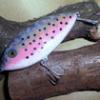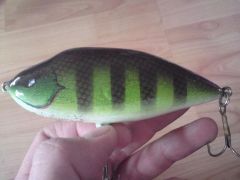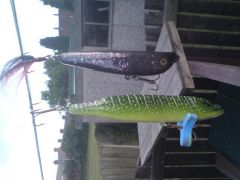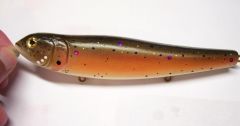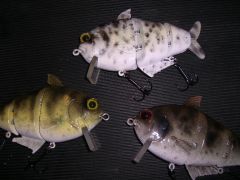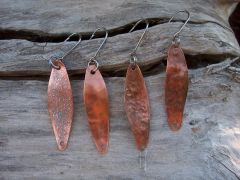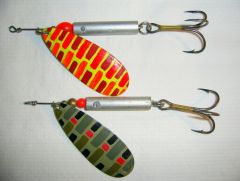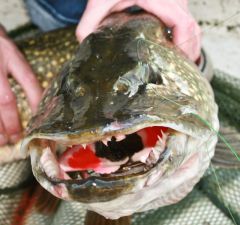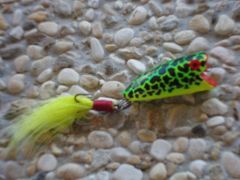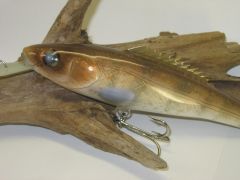-
Posts
3,867 -
Joined
-
Last visited
-
Days Won
23
Content Type
Profiles
Articles
TU Classifieds
Glossary
Website Links
Forums
Gallery
Store
Everything posted by diemai
-
@ Mart By the way your wire is bent I can figure out , that it must have been quite hard to bend it ,...... I guess , that a more "fine grade" wire form is essential . Also you need space at the bottom(belly) to set in weights , so you must place the wire form higher(thus it has to be entirely smaller) . good luck , diemai:yay:
-
@ Boskabouter I remember , that there were similar lures posted in here before , one in a thread by one guy from Canada(if my memory serves me right) , and another one in the gallery , I think , by one of our Swedish members . But especially the first one mentioned was already at least 6 months ago , certainly more ??? I think , that your blades are too large in relation to the body , especially the brass ones . Though all blades always tend to right at the highest level , their circular force could let the lure swim laying sideward , if not sufficient counterweight is provided . I am not very fond of sucha rigid connection between wooden body and blade arm either , I'd make the blade arm detacheable , even only for storage reasons . I have seen such detacheable (buzz)blade arms in a luremaking book for the first time , connected to a sinking lipless crank(Ratt'L'Trap) to render it a surface buzzbait , also to the tail eye of a "Rapala Original"(rear hook switched to tow eye) for same purpose . I have made such detacheable blade arms to rig to leadheads and spoons , but undoubtely they would work on sinking gliders as well , provided , that the blade is not too large . The larger a blade , the more resistance it has on retrieve and thus the more it would tend to ride more to the rear , changing the level of a lure mounted rigid to them . good luck , Dieter:yay:
-
I'd tape on the weights with cable insulation plastic tape for testing , comes off easy as long as it's still wet , ......when it has dried , it sometimes tears off my temporary acrylic topcoat when peeling off ,...........but I'd sand that one over prior to priming , anyway . Such problem shouldn't occur on PVC , though , since no temporary sealing is neccessary . greetz , diemai:yay:
-
-
-
-
-
-
-
@ Bassman82 Congrats on your first muskie , always the one to remember through your entire lifetime;) ! Happy if I could help a bit:yes: ,........greetz , diemai:yay:
-
-
@ masterlure Should not be a problem to order from any other European country ,........checked some links from a German luremaking site for you , maybe , you'll find what you need there ? Modulor:*HOME (spanish , italian and english version available) suter swiss.composite group (english and french version available) Modellbaukiste (German only) Breddermann Kunstharze - Onlineshop (German only) good luck , diemai:yay:
-
@ spoopa As far as for the casting , in Europe we most likely utilise spinning reels mounted to 8 to 12 feet rods and possibly thin braid ,..... I guess with my gear I could get at least 40 yards out of your spoons:huh: , if they were 1/20" thick ,...... if about 1/10" thick , 60 to 70 yards would be possible(without too much wind) . Casting gear is not much suited for smaller and lighter lures , I know ,.... only use it for heavier glider and topwater baits . greetz , Dieter:yay:
-
Thanks for posting , Jacob ,....l like their outline shape , ....a tad wider than my own slender models and center of gravity a bit to the rear for better casting ,.......real nice design:yes: ! I suppose , that they also have a crosswise cupping , not visible on this view of them . Copper sheet is easy to work with , but I have found , that I tend to make the cupping of copper spoons too deep , since the material is quite soft(I'm used to stainless steel) . Not that important on slender models , but wider spoons cupped too deep would have a tendency to flip over and not wiggle anymore . Thanks again:yay: , Dieter
-
-
-
-
@ masterlure I don't think , that one can make such transparent lure halves at home , since the technical process it too elaborate and requires complexe machinery . What you can actually do , is to cast lures from resin(but these won't be transparent) in a homemade mold made with a masterlure . The neccessary items are available through the web . These are cast in one piece , their buoancy is not achieved by trapped air in them , but by adding buoyant material to the resin when mixing it . But I don't know anything about it , since I only build wooden and metal lures , but there are some guys around in here , that do ,........do a forum search with terms like "resin lures" , "molded lures" , "microballs" , "cast lures" , .etc. , I am sure , that you'll find some more info . good luck , diemai:yay:
-
@ spoopa Just my theories , Jacob:huh: , ........if the lure starts to roll or capzise to say i. e. 45
-
This one turned out very beautiful , ...nice paintjob :yes:! Such popper lures most likely should not be weighted to keep their cupped head planes high enough above the surface ,.......just make sure to rig the tail hook somewhat UNDER the tail to act as a keel weight(a belly hook does that automatically) , ....the less buoyant tapered tail would let them swim a a little "nose up", anyway ! well done:yes: , ...greetz , diemai:yay:
-
@ spoopa I had figured out before about those spindle shaped , lathe-turned blanks to be difficult to wiggle nicely , ......they most likely tent to roll too much for my liking , ...especially with an "ordinary" , pointing somewhat downward lip (like a "Rapala Original" , "Bomber" , etc.) . To prevent too much body roll they should have some kind of plane on their heads , a kinked lip (like "Creek Chub Pikie" , "Heddon's Wiggler" , etc.) does it even better . The lures gain more sideward stability on retrieve this way , since the water pressure on those planes or downward pointing portions of the kinked lips tracks them back faster , when rolling sideward , thus the lures do wiggle better . The slots for such "Pikie" style lips are easier to cut under correct angle and plane , anyway , since they go down somewhere from the nose just parallel to the lengthwise center axis . One can just carefully clamb the lureblank vertically in a vise(utilise some softwood blocks or very thick cardboard either side to prevent blemishes on the blank) , support it with one hand(since it still should not be fixed too hard to squeeze)and cut with a woodsaw . The shorter such lure blanks are in relation to their greatest diameter , the more pronounced they would wiggle ,.........at least as a rule of thumb:huh: ! good luck:yay: , Dieter
-
@ masterlure Hi , welcome to TU ! I guess , by "transparent crankbaits" you are refering to those plastic baits , glued together from two halves ???? You can buy such lure kits at :-:-: Lure Making :-:-: The Official LureMaking.com Website | Tackle Components | Lure Components | Lure Making Information | Lure Making Supplies . Or you are refering to the transparent lip material ? That one is called "Lexan" , another trade name for it is "Makrolon"(Bayer/Germany) . greetz , diemai:yay:
-
-
@ spoopa Jacob , ....funny , but I also don't remember , on which ocassion I mentioned turning a lure in my lathe with an off-centered block:huh: ????????? But it surely wasn't about making lipslots prior to having turned the lure blank finish , since I never tried to cut the lip slot this way . Only made such experiments on round lureblanks , that had a kink somewhere along their length or in center . I'd first turn one side finish , after set in the lathe's center tip into another offset countersunk on one side of the stock and then turn the second part of the blank ,...... the transition between these two disaligned body portions I'd smoothen by hand . Used rectangular stock for this , wasn't very satisfying , though ,......only made two sinking gliders that way . Anyway .......sorry for a little off-topic . I believe that I have mentioned turning an off-centered blank from rectangular stock and leaving the flanks plane , virtually only rounding back and belly ,.... blank ends either , off course . I guess , that I have mentioned , that the flanks would most likely turn out uneven this way , so I had thought about turning the lure from square blank(or previously cutting a square end to a round dowel) ,......leaving the square dowel end connected to the blank and utilized this square end to clamp the finished blank under certain angles into the vise of my hobby routing machine to cut the flanks even and symetrically and also the lip slot perfectly angled . Guess , that would be , what you had read about , just came into my mind as writing this post ????? greetz , Dieter:yay:
-
@ mark poulson Mark , your describtion sounds almost exactly like the swimming action of my recently uploaded "Jointed Rolf's Wiggler" , that one also swims in a sharp "S" pattern on a slow retrieve , on a faster pace that "S" swing becomes narrower ,........and also points its nose somewhat backward towards the angler on the end of a jerk . Some time ago Jeep had uploaded gallery pictures and a video on the lure action of a two sectioned swimbait , that did provide that typical "snake" action , and I also have a small commercial one(approx. 3") , that acts like this , too . This one is shaped symetrically in sideview , just like a willowleaf and jointed right in the middle , a Danish lure named "Jack Rapid" ,.............also Jeeps lure is rather more slender in body shape . So now my theory is , that a high-bodied two-sectioned swimbait acts the way you have described , simply because its high body profile makes up for more GUIDANCE in the water , ....it acts more like a RUDDER , thus swimming that way . A more slender profile does not do this as much , the front section only breaks out sideward due to the leverage around the tow eye , the line pull forces it back and break out to the other side and as it pulls its tail section behind , the whole lure does that "snake" swimming . I don't think , that any weighting issues would chance a thing to a high body profile still swimming that "S" pattern . On a three ,-or even four section high bodied profile this does not happen , since the single sections are shorter , so they cannot evolve this "rudder"-like force . Just my theories........ ! good luck , Dieter:yay:



